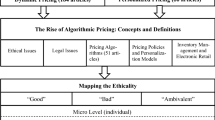Abstract
When an outside innovating firm has a cost-reducing technology, it can sell licenses of its technology to incumbent firms using a combination of royalty and fixed fee. Alternatively, the innovating firm can enter the market and at the same time sell licenses, or enter the market without license. We examine the credibility of the threat of entry by the innovating firm using a two-step auction under oligopoly with three firms, one outside innovating firm and two incumbent firms. With general demand function, we show that the credibility of the two-step auction depends on the form of the cost function of the new technology, whether it is concave or convex. Also we analyze the optimal strategy for the innovator in a case of linear demand and quadratic cost functions in which the two-step auction is credible.


Similar content being viewed by others
Notes
Please see Section 6.2.2.
About the meanings of strategic substitutability and complementarity, please see Section 4.1
The definitions of strategic substitutability and complementarity are according to Bulow et al. (1985).
This is a stability condition in the case of duopoly with Firm A and Firm B.
This property of the cost function is called strict super-additivity. Thus, strict convexity of the cost function with zero fixed cost implies strict super-additivity.
This property of the cost function is called strict sub-additivity. Thus, strict concavity of the cost function with zero fixed cost implies strict sub-additivity.
More details of calculations such as the equilibrium values of the outputs and profits are available upon request.
References
Boone J (2001) Intensity of competition and the incentive to innovate. Int J Ind Organ 19:705–726
Bulow J, Geanakoplos J, Klemperer P (1985) Multimarket oligopoly: strategic substitutes and strategic complements. J Political Econ 93:488–511
Chen CS (2017) Endogenous market structure and technology licensing. Jpn Econ Rev 68:115–130
Creane A, Chiu YK, Konishi H (2013) Choosing a licensee from heterogeneous rivals. GEB 82:254–268
Dixit A (1986) Comparative statics for oligopoly. IER 27:107–122
Duchene A, Sen D, Serfes K (2015) Patent licensing and entry deterrence: the role of low royalties. Economica 82:1324–1348
Hattori M, Tanaka Y (2015) Subsidy or tax policy for new technology adoption in duopoly with quadratic and linear cost functions. Econ Bull 35:1423–1433
Hattori M, Tanaka Y (2016a) Subsidizing new technology adoption in a Stackelberg duopoly: cases of substitutes and complements. Ital Econ J 2:197–215
Hattori M, Tanaka Y (2016b) License or entry with vertical differentiation in duopoly. Econ Bus Lett 5:17–29
Hattori M, Tanaka Y (2018) License and entry strategies for an outside innovator under duopoly. Ital Econ J 4:135–152
Kabiraj T (2004) Patent licensing in a leadership structure. The Manchester School 72:188–205
Kamien T, Tauman Y (1986) Fees versus royalties and the private value of a patent. QJE 101:471–492
Kamien T, Tauman Y (2002) Patent licensing: the inside story. The Manchester School 70:7–15
Katz M, Shapiro C (1985) On the licensing of innovations. Rand J Econ 16:504–520
La Manna M (1993) Asymmetric oligopoly and technology transfers. EJ 103:436–443
Liao C, Sen D (2005) Subsidy in licensing: optimality and welfare implications. The Manchester School 73:281–299
Matsumura T, Matsushima N, Cato S (2013) Competitiveness and R&D competition revisited. Econ Model 31:541–547
Pal R (2010) Technology adoption in a differentiated duopoly: Cournot versus Bertrand. Res Econ 64:128–136
Rebolledo M, Sandonís J (2012) The effectiveness of R&D subsidies. Econ Innovat New Tech 21:815–825
Seade JK (1980) The stability of Cournot revisited. J Econ Theory 23:15–27
Sen D, Tauman Y (2007) General licensing schemes for a cost-reducing Innovation. GEB 59:163–186
Wang XH, Yang BZ (2004) On technology licensing in a Stackelberg duopoly. Aust Econ Pap 43:448–458
Watanabe N, Muto S (2008) Stable profit sharing in a patent licensing game: general bargaining outcomes. Int J Game Theory 37:505–523
Funding
This work was financially supported by Japan Society for the Promotion of Science KAKENHI Grant Number 18K01594 and 18K12780.
Author information
Authors and Affiliations
Corresponding author
Additional information
Publisher’s Note
Springer Nature remains neutral with regard to jurisdictional claims in published maps and institutional affiliations.
Appendices
Appendix A. Details of Calculations
Appendix B. Stability Conditions
According to Seade (1980) and Dixit (1986), we consider stability conditions for a duopoly and an oligopoly. Consider the following matrix for a duopoly with Firm B and Firm C.
sB and sC are adjustment speeds of the outputs of Firms B and C. For the stability, the trace of this matrix must be negative, and its determinant must be positive. Therefore,
and
Since these are to hold independently of sB and sC, we need
Consider the following matrix for an oligopoly with Firms A, B, and C.
sA, sB, and sC are adjustment speeds of the outputs of Firms A, B, and C. One necessary condition is that the trace of this matrix is negative. Therefore,
Since this is to hold independently of sA, sB, and sC, we need
Another necessary condition is that the determinant of this matrix has the sign of (− 1)3, that is, it is negative. Thus,
The second-order conditions in each case 𝜃A < 0, 𝜃B < 0, 𝜃C < 0 with the stability conditions guarantee the existence of the locally unique stable Nash equilibrium. If the stability conditions are violated, the firms increase (or decrease) their outputs more than a change (increase or decrease) in the rival firm’s output, and then the outputs of the firms diverge from the equilibrium values. For the existence of the globally unique equilibrium, we need that 𝜃A < 0, 𝜃B < 0, 𝜃C < 0 globally hold.
Rights and permissions
About this article
Cite this article
Hattori, M., Tanaka, Y. Entry of Innovator and License in Oligopoly. J Ind Compet Trade 20, 709–731 (2020). https://doi.org/10.1007/s10842-020-00334-4
Received:
Revised:
Accepted:
Published:
Issue Date:
DOI: https://doi.org/10.1007/s10842-020-00334-4




